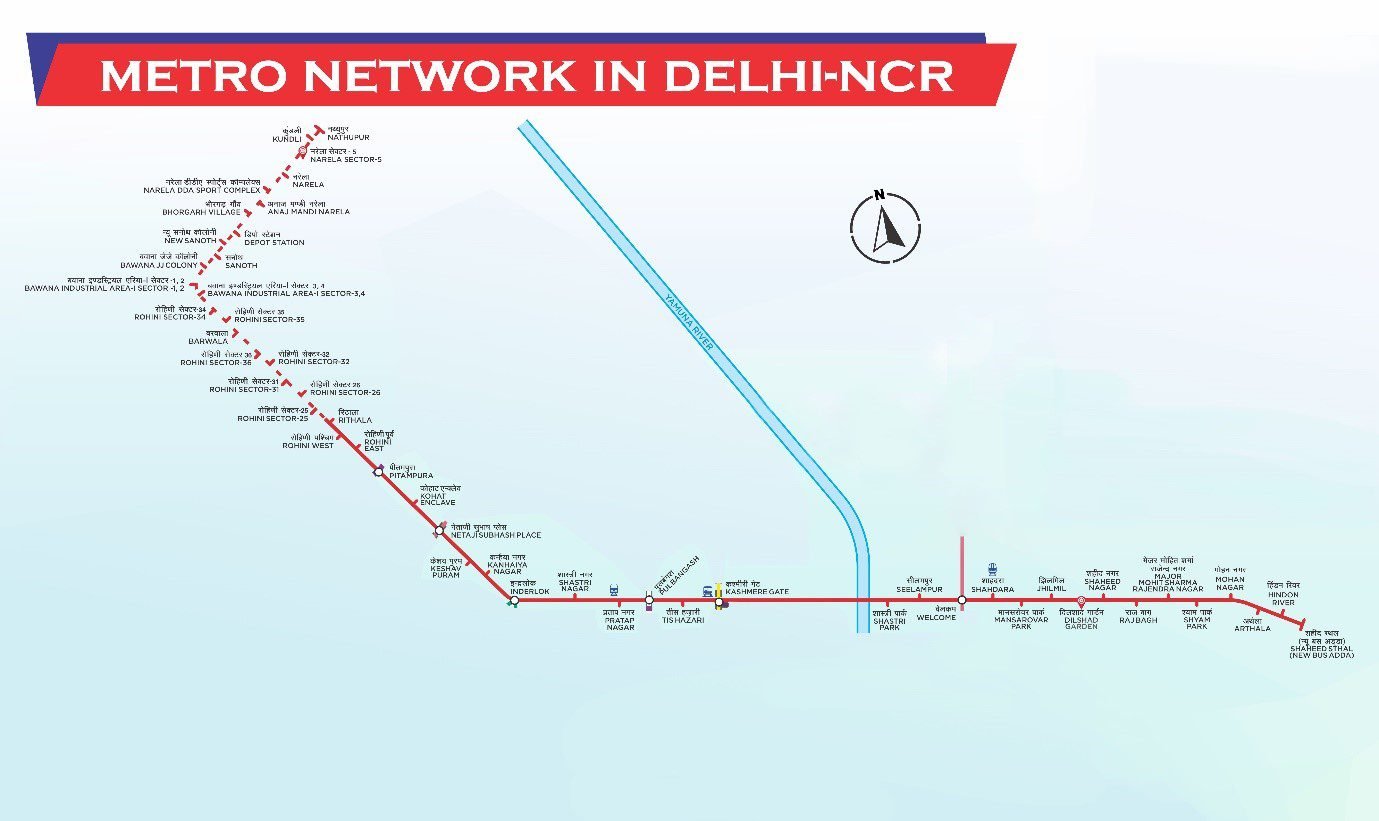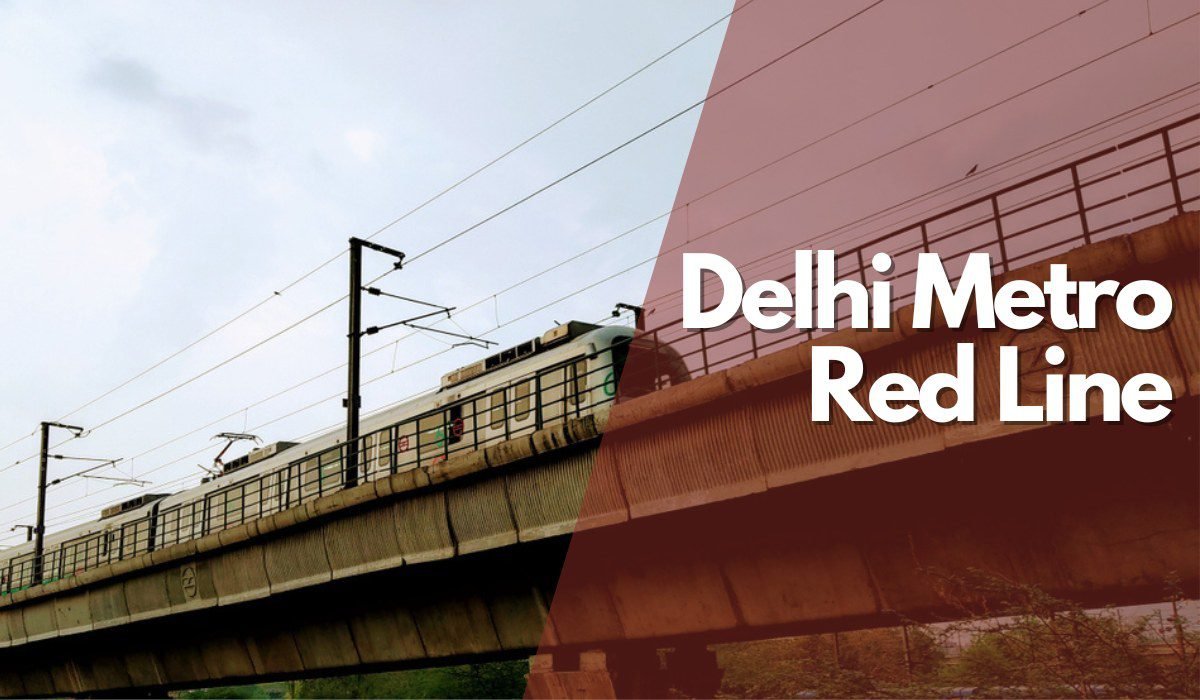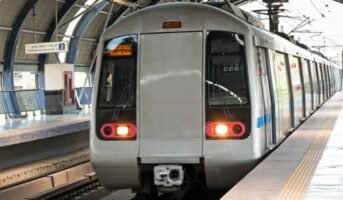The Delhi Metro Red Line, which has the distinction of being the first operationalised corridor of the Delhi Metro, joins Rithala in northwest Delhi to Shaheed Sthal (New Bus Adda) in Ghaziabad. While passing through some of the most significant junctures in the national capital, the Delhi Metro Red Line acts as a crucial connectivity route.
Delhi Metro Red Line: Key facts
| Name | Line 1 |
| Owner | DMRC |
| Built under | Phase-1 |
| Opened to public | December 24, 2002 |
| Type | Elevated (Welcome and Shahdara stations are on surface) |
| Length | 33.48 km |
| Inauguration | April 3, 2010 |
| Number of stations | 29 stations |
| Number of interchange stations | 4 |
| First station | Shaheed Sthal (New Bus Adda) |
| Last station | Rithala |
| Interchange stations | 4 |
| Train speed | 80 kmh |
| Train frequency | 4-10 minutes |
| Timings | 5:30 AM to 11:30 PM |
| Travel time | 46 minutes |
| Ticket price | Rs 10 to Rs 60 |
Delhi Metro Red Line: Progress
Delhi Metro Red Line’s 8.2-km stretch between Tis Hazari and Shahdara stations was opened on December 24, 2002, by then prime minister Atal Bihari Vajpayee. The route has reached its current length of 34.72 km after going through several extensions.
Delhi Metro Red Line: Extension
1st stretch: Shahdara-Tis Hazari
Built under: Phase-1
Opening date: December 25, 2002
Length: 8.35 km
Stations: 6
2nd stretch: Tis Hazari-Inderlok
Built under: Phase-1
Opening date: October 3, 2003
Length: 4.87 km
Stations: 4
3rd stretch: Inderlok-Rithala
Built under: Phase-1
Opening date: March 31, 2004
Length: 8.84 km
Stations: 8
4th stretch: Shahdara-Tis Hazari
Built under: Phase-2
Opening date: June 4, 2008
Length: 2.86 km
Stations: 3
5th stretch: Dilshad Garden-Shaheed Sthal, New Bus Adda
Built under: Phase-3
Opening date: March 8, 2019
Length: 9.63 km
Stations: 8
Delhi Metro Red Line: Stations
| Delhi Metro Red Line station list 2024 | Delhi Metro Red Line station list in Hindi 2024 | Interchange Stations |
| Shaheed Sthal (New Bus Adda) | शहीद स्थल (नया बस अडडा) | Ghaziabad Junction Railway Station |
| Hindon | हिंडन | |
| Arthala | अर्थला | |
| Mohan Nagar | मोहन नगर | |
| Shyam Park | श्याम पार्क | |
| Major Mohit Sharma | मेजर मोहित शर्मा | |
| Raj Bagh | राज बाग | |
| Shaheed Nagar | शहीद नगर | |
| Dilshad Garden | दिलशाद गार्डन | |
| Jhilmil | झिलमिल | |
| Mansarovar Park | मानसरोवर पार्क | |
| Shahdara | शाहदरा | |
| Welcome | वेलकम | |
| Seelampur | सीलमपुर | |
| Shastri Park | शास्त्री पार्क | |
| Kashmere Gate | कश्मीरी गेट | Yellow Line, Violet Line, ISBT Kashmere Gate |
| Tis Hazari | तीस हजारी | |
| Pul Bangash | पुल बंगश | |
| Pratap Nagar | प्रताप नगर | |
| Shastri Nagar | शास्त्री नगर | Sarai Rohilla Railway Station |
| Inderlok | इंद्रलोक | Green Line (Main) |
| Kanhiya Nagar | कन्हैया नगर | |
| Keshav Puram | केशव पुरम | |
| Netaji Subhash Place | नेताजी सुभाष प्लेस | Pink Line |
| Kohat Enclave | कोहाट एन्क्लेव | |
| Pitampura | पीतम पुरा | |
| Rohini East | रोहिणी पूर्व | |
| Rohini West | रोहिणी पश्चिम | |
| Rithala | रिठाला |
Delhi Metro Red Line: Route map 2024

Source: DMRC
Delhi Metro Red Line: Fare in 2024
The fare on this line would depend on the distance covered.
| Distance covered | Fare | Time limit in minutes | |
| Monday to Saturday | Sundays and public holidays | ||
| 0-2 | Rs 10 | Rs 10 | 65 |
| 2-5 | Rs 20 | Rs 10 | 65 |
| 5-12 | Rs 30 | Rs 20 | 65 |
| 12-21 | Rs 40 | Rs 30 | 100 |
| 21-32 | Rs 50 | Rs 40 | 180 |
| More than 32 | Rs 60 | Rs 50 | 180 |
Delhi Metro Red Line: Train frequency
Dilshad Garden to Rithala
Peak hours
Weekday: 3 min 21 sec
Saturday: 3 min 41 sec
Sunday: 5 min
Non-peak hours
Weekday: 4 min
Saturday: 4 min 15 sec
Sunday: 5 min
Dilshad Garden to New Bus Adda
Peak hours
Weekday: 6 min 42 sec
Saturday: 7 min 22 sec
Sunday: 10 min
Non-peak hours
Weekday: 8 min
Saturday: 8 min 30 sec
Sunday: 10 min
Red Line: Significance
The Red Line is the oldest and one of the most significant corridors of the DMRC network in terms of passenger utilisation (around 4.7 Lakh per day at present) with four existing interchange stations, namely Welcome, Kashmere Gate, Inderlok, and Netaji Subhash Place. Two more stations – Pul Bangash and Pitampura on the Red Line will also become interchange stations after the completion of Phase-IV. The first six-coach train service on the Delhi Metro network was introduced on the Red Line in 2013.
Delhi Metro Red Line: Real estate impact
Strategic connectivity
The Red Line links Ghaziabad in Uttar Pradesh to Shahdara, Central Delhi, and northwest Delhi. It serves as a vital connection for commuters from west Delhi and northwest Delhi heading towards Central Delhi, Shahdara, east Delhi and Ghaziabad and vice-versa.
Commercial centres
By acting as the lifeline for several commercial centres in the national capital, the Red Line has also made them more accessible, boosting their commercial value. These include the Kashmere Gate ISBT area, the Ghaziabad Railway Station, the Shahdara Railway Station, the Sarai Rohilla Railways Station, and the Tis Hazari Court.
Residential areas
The Red Line provided connectivity to several underdeveloped areas in the national capital, boosting their value. Improved last-mile connectivity to several under-developed localities led to a higher level of densification and an increase in land and property prices. Rithala and Ghaziabad are an example of that.
Delhi Metro Red Line: Impact on property prices
| Name of area | Prior to metro arrival | After metro arrival | Average property rate before metro psf | Property rate after metro psf |
| Shaheed Sthal (New Bus Adda) | Underdeveloped area, limited connectivity | Improved connectivity; residential, commercial development | Rs 4,000 | Rs 7,000 |
| Hindon | Industrial, limited residential connectivity | Improved connectivity; residential, commercial development | Rs 5,000 | Rs 8,000 |
| Arthala | Village with limited connectivity | Improved connectivity; residential, commercial development | Rs 3,000 | Rs 6,000 |
| Mohan Nagar | Limited connectivity | Improved connectivity; residential, commercial development | Rs 6,000 | Rs 9,000 |
| Shyam Park | Residential, limited connectivity | Improved connectivity; residential, development | Rs 5,000 | Rs 7,000 |
| Major Mohit Sharma | Residential, limited connectivity | Improved connectivity; residential, development | Rs 6,000 | Rs 9,000 |
| Raj Bagh | Residential, limited connectivity | Improved connectivity; residential, commercial development | Rs 5,000 | Rs 8,000 |
| Shaheed Nagar | Residential, limited connectivity | Improved connectivity; residential, commercial development | Rs 5,000 | Rs 7,000 |
| Dilshad Garden | Residential, limited connectivity | Improved connectivity; residential, commercial development | Rs 7,000 | Rs 10,000 |
| Jhilmil | Industrial, limited connectivity | Improved connectivity; residential, commercial development | Rs 4,000 | Rs 8,000 |
| Mansarovar Park | Residential, limited connectivity | Improved connectivity; residential, development | Rs 6,000 | Rs 9,000 |
| Shahdara | Industrial; overcrowded | Improved connectivity; residential, commercial development | Rs 6,000 | Rs 10,000 |
| Welcome | Residential, overcrowded | Improved connectivity; residential, commercial development | Rs 4,000 | Rs 7,000 |
| Seelampur | Residential, overcrowded | Improved connectivity; residential, commercial development | Rs 5,000 | Rs 8,000 |
| Shastri Park | Residential, overcrowded | Improved connectivity; residential, commercial development | Rs 4,000 | Rs 7,000 |
| Kashmere Gate | Commercial, overcrowded | Improved connectivity; residential, commercial development | Rs 7,000 | Rs 20,000 |
| Tis Hazari | Commercial, overcrowded | Improved connectivity; residential, commercial development | Rs 7,000 | Rs 10,000 |
| Pul Bangash | Residential area; overcrowded | Improved connectivity; residential, commercial development | Rs 5,000 | Rs 8,000 |
| Pratap Nagar | Residential area with limited connectivity | Improved connectivity; residential, commercial development | Rs 4,000 | Rs 7,000 |
| Shastri Nagar | Residential area with limited connectivity | Improved connectivity; residential, commercial development | Rs 5,000 | Rs 7,000 |
| Inderlok | Residential area with limited connectivity | Improved connectivity; residential, commercial development | Rs 6,000 | Rs 8,000 |
| Kanhaiya Nagar | Residential area with limited connectivity | Improved connectivity; residential, commercial development | Rs 5,000 | Rs 8,000 |
| Keshav Puram | Residential area with limited connectivity | Improved connectivity; residential, commercial development | Rs 5,000 | Rs 8,000 |
| Netaji Subhash Place | Large commercial, overcrowded area | Improved connectivity; residential, commercial development | Rs 6,000 | Rs 9,000 |
| Kohat Enclave | Large residential area with limited connectivity | Improved connectivity; residential, commercial development | Rs 5,000 | Rs 10,000 |
| Pitampura | Large residential overcrowded area | Improved connectivity; residential, commercial development | Rs 5,000 | Rs 9,000 |
| Rohini East | Agricultural village with limited connectivity | Improved connectivity; residential, commercial development | Rs 4,000 | Rs 8,000 |
| Rohini West | Agricultural village with limited connectivity | Improved connectivity; residential, commercial development | Rs 4,000 | Rs 7,000 |
| Rithala | Agricultural village with limited connectivity | Improved connectivity; residential, commercial development | Rs 3,000 | Rs 9,000 |
Source: Housing.com
Reduced traffic congestion and pollution
By reducing vehicular traffic to some of the most densely populated and crowded areas in the city, such as Kashmere Gate ISBT and Old Delhi, the Delhi Metro Red Line has played a significant role in reducing traffic congestion. It has made a significant impact in lowering air and noise pollution in a city, infamous for having one of the worst air qualities in the world.
Proposed future expansion of Delhi Metro Red Line
Proposed Rithala-Narela corridor of Delhi Metro Red Line may get extended up to Kundli in Haryana
July 11, 2023: The proposed Rithala–Narela corridor of the Delhi Metro Red Line may possibly be extended up to Kundli in Haryana to provide additional connectivity to the neighbouring state. If approved, this will be Delhi Metro’s fourth expansion into Haryana after Yellow Line (Gurugram), Violet Line (Faridabad) and Green Line (Bahadurgarh).
This corridor is being planned as an extension of the presently operational Shaheed Sthal–Rithala Red Line corridor. In fact, this may be Delhi Metro’s first-ever corridor to connect Haryana and Uttar Pradesh via Delhi. Initially, smaller stations with platform lengths accommodating four coach trains were proposed to meet the initial traffic demand with a provision of future expansion to accommodate eight coach trains.
If approved, the entire corridor shall be 27.319 km, comprising 22 stations. While 26.339 km will be elevated, about 0.89 km will be at grade. Of the 22 stations, 21 will be elevated and one will be at grade.
The proposed stations on this corridor are Rithala, Rohini Sector-25, Rohini Sector-26, Rohini Sector-31, Rohini Sector-32, Rohini Sector-36, Barwala, Rohini Sector-35, Rohini Sector-34, Bawana Industrial Area – 1 Sector 3,4, Bawana Industrial Area – 1 Sector 1,2, Bawana JJ Colony, Sanoth, New Sanoth, Depot Station, Bhorgarh village, Anaj Mandi Narela, Narela DDA Sports Complex, Narela, Narela Sector-5, Kundli and Nathpur.
The Delhi Development Authority (DDA) has launched its housing schemes with more than 3,500 flats located in Narela. This enhanced connectivity to these areas will immensely help residents of these new residential colonies. Such an extension of the Red Line would also connect this region with the already operational Red Line, which goes all the way up to Ghaziabad in Uttar Pradesh, covering important locations in central and east Delhi.
The revision of the route alignment including station planning for all the stations has been done. The topographical survey, traffic survey, environment impact assessment study for the extended portion from Narela to Kundli (5 km length) are in progress. The revised Detailed Project Report for the Rithala-Narela–Kundli corridor is expected to be submitted by July 2023. The report after finalisation will be submitted to the government for consideration.
Housing.com Viewpoint
The Delhi Metro Red Line serves as a lifeline for Delhiites by not only connecting them to vital commercial and residential areas but also by offering a sustainable and efficient mode of transportation that positively impacts the city’s economy, environment, and overall quality of life.
News update
DMRC launches India’s first indigenously developed signaling system on Red Line
February 18, 2023: In a significant development in the field of rail-based mass transit, the Delhi Metro launched India’s first indigenously developed Train Control & Supervision System, the i-ATS (Indigenous – Automatic Train Supervision), for operations on its first corridor, Red Line (Rithala to Shaheed Sthal). The i-ATS system was formally launched on the Red Line from the Operations Control Centre, Shastri Park. With this milestone, India is the sixth country now joining the elite list of a few countries in the world which have their own ATS products. Beginning with the Red Line, the i-ATS System will further be deployed for operations on Delhi Metro’s other operational corridors and the upcoming independent corridors of Phase–4 Project as well.
DMRC launches eight-coach trains on Red Line
November 8, 2022: The Delhi Metro Rail Corporation introduced its first set of two eight-coach trains for passengers on the Red Line. In 2021, the conversion of all six-coach trains into eight-coach trains on the Yellow Line and Blue Line was completed successfully by adding additional coaches to their remaining fleet of six-coach trains. These lines, which were initially made operational under Phase-I, were built on Broad Gauge having provision of running trains up to eight-coach formation. The remaining corridors of the Delhi Metro network including the Airport Express Line, which were subsequently constructed in Phase-II and Phase-III, were built on standard gauge having provision of running trains up to six-coach formation.
FAQs
How many stations does the Red Line of the Delhi Metro have?
The Red Line of the Delhi Metro consists of 29 stations.
Which station marks the beginning of the Red Line Metro in Delhi?
Shaheed Sthal and Rithala are the starting stations at either side of the Delhi Metro Red Line.
Which stations are among the most frequented on the Red Line metro in Delhi?
Kashmere Gate is the most frequented stop on the Red Line of the Delhi Metro.
What time does the first train depart from the Red Line in Delhi?
The first train on the Red Line of the Delhi Metro departs at 5:30 AM.
When is the last train scheduled to depart from the Red Line in Delhi?
The last train on the Red Line of the Delhi Metro departs at 11:30 PM.
Which metro line is the longest in Delhi?
The Pink Line is the longest one running 59 km and 38 stations.
Which is the shortest Delhi Metro line?
The shortest line in Delhi Metro is the Grey Line running 5.19 km with four stations.
Which is the first metro line in Delhi?
The Red Line was the first line of the Delhi Metro to be constructed and opened.
| Got any questions or point of view on our article? We would love to hear from you. Write to our Editor-in-Chief Jhumur Ghosh at [email protected] |

An alumna of the Indian Institute of Mass Communication, Dhenkanal, Sunita Mishra brings over 16 years of expertise to the fields of legal matters, financial insights, and property market trends. Recognised for her ability to elucidate complex topics, her articles serve as a go-to resource for home buyers navigating intricate subjects. Through her extensive career, she has been associated with esteemed organisations like the Financial Express, Hindustan Times, Network18, All India Radio, and Business Standard.
In addition to her professional accomplishments, Sunita holds an MA degree in Sanskrit, with a specialisation in Indian Philosophy, from Delhi University. Outside of her work schedule, she likes to unwind by practising Yoga, and pursues her passion for travel.
[email protected]











